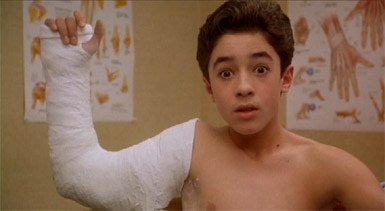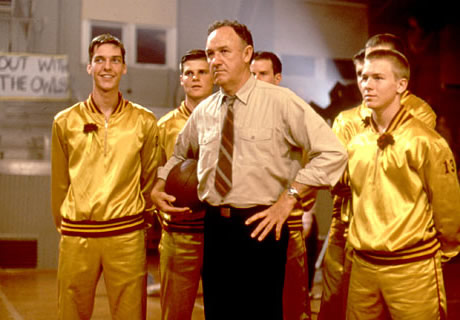WARNING: UNSURPRISING SPORTS MOVIE SPOILERS

I have a secret for you. The kid in the picture is the greatest pitcher who ever lived.
In fact, breaking his arm made him a better pitcher. Tons better. Not practice, not genetics, not HGH, but a freak accident, breaking his arm.
What, you don’t believe me?
Previously, I discussed how sports movies invert reality. Not only are the events and characters in a movie so often fantastical and strange, but they lie—they come out and say the opposite of what they mean. There may not be crying in baseball, but there is crying in baseball movies.
I hate to break it to you, but out of the subset of folks who can throw a ball over a plate, a 14-year-old boy with a broken arm is probably one of the worse pitchers in the world.
When you watch the movie (Rookie of the Year, a classic), that may not be what you see, but it’s still what you believe. And the way the movie ends backs it up. The kid has this tremendous gift, but he’s still a bad baseball player, and he manages to get by almost entirely on luck. You see him strike out major leaguers, but in the end, the movie is about how puberty is sometimes weird and dysfunctional and about playing the game even when you suck.
The tremendous gift (his fracture-enhanced 100+ mph fastball) is the counterfactual that turns this from a movie about a truth that is difficult to handle that nobody would watch into a sports movie.

Consider this: If you had never seen Hoosiers before, and I asked you to bet on whether the team in Hoosiers wins the big game, how would you bet?
Any good overthinker knows Gene Hackman and friends are the the strong favorites on our side of the looking glass, even if they’re underdogs on the other side. In the world of the sports movie, always bet on the plucky underdog, unless they look suspiciously like they might learn a valuable lesson about friendship. Then don’t bother putting your money on the table.
Stories of weakness are told as stories of strength, and stories of strength are told as stories of weakness. We get to the truth by inversion. “The Good News Yankees” isn’t exactly burning up Netflix queues. The only famous movie about the Yankees involves the best one of them dying of a horrible debilitating illness (I warned you, SPOILERS!!!).
A movie about the strongest, most resilient player on the strongest, most dominant team of its day focuses on the one day he can’t play anymore. And the lesser-known movie The Babe also tells a story of greatness by focusing on the things that were not great.
The movies are not meant to undermine or to show weakness — when these players lived, they were cheered for their strength, not their vices or vulnerability (unless you count holding more liquor than a Chicago warehouse a vice or vulnerability). And these movies still cheer for them. It is only in the sports movie that they have to be seen as weak, because the sports movie has to invert reality to function.
It refracts perspective, so that the depiction and the reaction are twisted and reconnected in a Moebius Strip of training montages and excessive celebration scenes. And the result is a very familiar genre that has a deceptively complex and important role in the emotional lives of contemporary American men.
Add a Comment